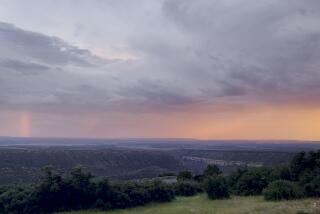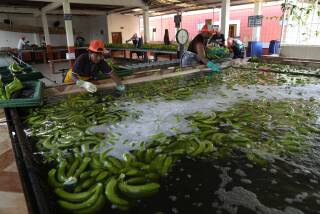Mindo, Ecuador’s cloud-forested wonderland
- Share via
I’ve often fantasized about retracing the steps of such naturalists as Charles Darwin, Alexander von Humboldt and William Bartram, who saw exotic places and recorded, in detail, the plants and animals they described so vividly on their expeditions.
FOR THE RECORD:
Mindo, Ecuador: An April 4 Travel article about the orchids of Ecuador’s cloud forests reported the size of El Pahuma, a private reserve, as 100 acres. The reserve is 700 acres. —
But the armchair naturalist in me didn’t want to work too hard or subject myself to the tribulations they suffered as they circumnavigated the globe, climbed the South American Andes or slogged through the swamps of the Southeastern United States, all places where one might encounter sharks, bugs, snakes, piranhas, jaguars and crocodiles. So, I kept deferring on the grounds of time, cost and discomfort.
My visit to Mindo, in a cloud-forested valley of the same name, helped me realize that I didn’t have to set sail or strap on the crampons to see spectacular and exotic life forms. Mindo is an easy-access epicenter of biodiversity in northwestern Ecuador teeming with hundreds of orchid and bird species, all framed by spectacular Andean scenery in a cool, temperate climate.
During my two days traipsing around Mindo — a 90-minute-drive from Quito, the capital— I spied scores of plant and bird species that I thought I’d have to travel much farther to see. There were netherworldly orchids (about 4,000 species grow in Ecuador) and vibrantly colored bromeliads and dozens of rare birds, including toucans, cocks-of-the-rock, quetzals and swarms of hummingbirds and parrots.
Ecuador’s biodiversity so engaged me that I thought of it as the ultimate persuasion for preservation, here and elsewhere. Bigger picture: Surely the ranks of protectors would swell, I reasoned, if they were to come away with the same understanding I did.
The smaller picture was just as satisfying. Although I’m no “orch-idiot,” as the locals call rabid orchid fans willing to surmount any obstacle to catch a glimpse of one, I am fascinated by these plants, masterpieces of nature’s handiwork. I saw scores of orchids along the several trails I hiked and in many of the 50 private reserves that locals have created to appeal to amateur, leisurely naturalists like me.
Ecuador’s stable and temperate climate in the highlands makes it a veritable flora factory. With nearly $600 million in shipments, Ecuador is the second leading exporter of cut flowers (Colombia is first) to the U.S.
Orchids may be the showstoppers, but the supporting cast is just as impressive: I saw two-story-high tree ferns, ancient cedars, giant hibiscus and philodendrons with leaves as big as elephant ears. I was agog at the enormous shiny silver leaves of the umbrella-shaped cecropia trees that some experts say can grow as much as 6 feet a year.
For this, credit the surrounding cloud forest, a specific variety of tropical or subtropical ecosystem that occurs at just the right mix of altitude — Mindo’s valley varies from 4,500 to 8,000 feet — cloud cover, sunlight, mild temperatures and moisture. Rainfall here averages 5 feet or more per year. The cloud forests often are in an altitude “band” between 3,000 and 6,000 feet and cover the many valleys that cut away from the altiplano where Quito (altitude: 9,400 feet) sits and open up to the Pacific Coast plain to the west below.
It rains almost every day, but much of Mindo’s wetness comes from condensed moisture, or evapo-transpiration, from clouds that hover at canopy level, particularly after noon. Moss covers many of the trees. In this botanical caldron, orchids, bees, hummingbirds and the other pollinators they depend on thrive.
Mindo is well-known in birder circles, I’m told. The valley is a perennial high scorer in the Audubon Society’s annual global bird count. Every December, localities around the world compete for the most bird species spotted, and Mindo, where as many as 400 have been counted some years, consistently places in the top 10.
As for birds, I found strikingly beautiful specimens seemingly everywhere. Actually, I didn’t find them; they found me me. Toucans frolicked in the trees during my visit to the Cabañas Armonía hostel’s orchid garden. Ten minutes out on one of our expeditions up an abandoned road, a brilliantly red cock-of-the-rock eyed us imperiously from a tree branch 50 feet away. The birds with their puffed heads and brilliant red color are prize sightings, and I “bagged” mine from the seat of my guide’s van. Hummingbirds by the dozens fluttered just outside my room and around the 500-acre nature reserve of my hotel, El Séptimo Paraíso (Seventh Heaven). Best of all, unlike the journeys undertaken by my naturalist heroes, my trip involved no sacrifice of creature comforts. Mindo, a town of about 15,000, and its environs are filled with a variety of hotels, from basic to luxury. Seventh Heaven, where rooms go for about $150 a night, was on the expensive side of the spectrum. On the other end is the Cabañas Armonía, perfectly adequate and going for $16 per person a night.
Part of Mindo’s charm is that it is preternaturally quiet, broken only by bird calls. It helps that a road built 20 years ago that connects Quito with the coast bypassed Mindo. The old road, which runs through town, has become a rarely traveled byway that serves as a path for nature-loving bikers or sightseers in vans.
A good guide is essential to a successful trip because he or she will see and hear things, particularly in dense, foggy forest, that inexperienced interlopers would miss. Thanks to a recommendation from a friend in Quito’s tourism industry, I got a great one: Kurt Beate, a multilingual German-Ecuadorean who has led tours throughout the country.
Even as a 34-year veteran, Beate is still passionate about his country and its embarrassment of natural riches and is generous with his knowledge of Ecuadorean flora and fauna. During my two days with him, I was treated to a nonstop flow of fascinating digressions, including how to identify certain birds by their calls, including hummingbirds (a strange clicking sound); quetzals (a descending trill); umbrella birds (a moo-ing sound, which is why Ecuadoreans call them bull birds) and toucans (a call in which they seem to be telling us, “Dios te de” or, in English, “God will provide.”)
On the way to Mindo from Quito, Kurt insisted that we make two stops, both of which proved unforgettable. The first was at Pululahua Crater, the innards of an extinct volcano 17 miles northwest of Quito that is now a national park. From a parking lot, we walked a couple hundred yards up to the crest of the crater to see the floor, its miles spread out before us, 1,000 feet below. Apart from a few houses and the crater floor’s green carpeted pastureland, it looked as though it might have erupted yesterday.
The other stop was at the privately owned 100-acre Pahuma Orchid Reserve (admission $4), about midway on the drive. We took an hourlong hike through the mists to Pahuma’s summit, passing several trailside orchids along the way, before descending to feast our eyes on more than 100 orchids and bromeliads growing in an outside nursery.
“Every plant is a surprise,” Kurt said smiling, after he photographed a blazingly pink epidendrum orchid. Its myriad tiny blooms reminded me of a pomegranate turned inside out.
It wasn’t all beauty during my two days in Mindo. The hike at Pahuma was a beast, straight up into dense tropical forest and thick cloud and dampness that tends to come on after 1 or 2 in the afternoon. We gained more than 800 feet of altitude in less than an hour. I was glad I had a plastic poncho and good weatherproof hiking boots. The mist and darkness made spotting orchids and other plants difficult. Fortunately, Kurt was adept at that.
But the rest of the time, I was back in my laid-back explorer mode, including my drive with Kurt up the abandoned Mindo-Quito road, where thanks to his telescopic “view-scope,” we saw several roadside orchids and the cock-of-the-rock. There was also my morning stroll through Seventh Heaven’s 800-acre reserve, with its flocks of clicking hummingbirds, and my pleasant walk around Cabañas Armonía’s orchid garden, where I encountered the colorful and mysterious geometry of a dracula orchid. It was just the right blend of education and enlightenment for the lazy man.
More to Read
Sign up for The Wild
We’ll help you find the best places to hike, bike and run, as well as the perfect silent spots for meditation and yoga.
You may occasionally receive promotional content from the Los Angeles Times.






